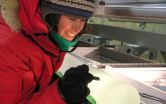(Press-News.org) Selective schools closures has been considered as a means of reducing transmission between children and hence reducing the number of cases at the peak of an epidemic but new research led by researchers at the University of Warwick shows that limited school closures are ineffective and that only significant widespread school closures would have real effect on the spread of a epidemic and the strain placed on hospital intensive care units.
Dr Thomas House from the University of Warwick's Mathematics Institute, and the University's Complexity Science research group said:
"Influenza potentially places an extreme burden on local health services. This was observed in both the 2009-10 swine-flu pandemic and this year's seasonal 'flu outbreak. Our work uses mathematical models to assess how school closures reduce the burden on particular hospitals. Although sustained national closures of schools can be very effective, they are costly and disruptive, and can even prevent parents in the health service from responding to any epidemic. We find in the worst cases, that short duration, localised closures cannot fully prevent some hospitals exceeding capacity. This means, when facing the threat of a severe pandemic, a coordinated and possibly extended period of school closures may be necessary."
The researchers found that even with broadly optimistic assumptions about school closures the proportion of hospitals above capacity in their intensive care units cannot be brought to zero and only achieves its lowest value of 12 per cent when there is a coordinated closure of at least 30 per cent of all English schools. In fact if less optimistic (but more realistic) assumptions are made about the timing and selection of closures there is no significant difference on the strain put on intensive care units until at least 50 per cent of all English schools are closed.
"Our work supports the decision not to close schools as a control measure during the 2009/10 swine 'flu pandemic," said Dr House. "If a pandemic is serious enough to require measures like school closures, then they need to be well timed and large scale to have much effect."
The Warwick research team appealed for more public help to create even bigger data sets to help future modeling of these problems that could help inform decision making in future epidemics. "The results in this work rely on existing information about local schools and hospitals, and yet tell us a lot about our ability to control pandemics. Yet, if we wish to devise more refined control methods, we need far more information about people's contact patterns and the behaviour of 'flu in the UK," said University of Warwick researcher Professor Matt Keeling. "Anyone can help with this by filling in the survey at our website www.contactsurvey.org, and by registering symptoms with our colleagues at www.flusurvey.org.uk."
INFORMATION:
The new research has just been published in Proceedings of the Royal Society B and is entitled Modelling the impact of local reactive school closures on critical care provision during an influenza pandemic" by
T. House, M. Baguelin, A. J. van Hoek, P. J. White, Z. Sadique, K. Eames, J. M. Read, N. Hens, A. Melegaro, W. J. Edmunds, M. J. Keeling,
link to journal article
http://rspb.royalsocietypublishing.org/content/early/2011/01/25/rspb.2010.2688.abstract
For further information please contact:
Dr Thomas House Mathematics Institute & Complexity Science
University of Warwick, Tel: +44 (0)7972 952588
T.A.House@warwick.ac.uk
Peter Dunn, Head of Communications, University of Warwick
Tel: +44 (0)24 76 523708 Mobile +44 (0)7767 655860 email p.j.dunn@warwick.ac.uk
PR11 PJD 2nd February 2011
Widespread school closures needed to stop strain on hospitals during epidemics
2011-02-03
ELSE PRESS RELEASES FROM THIS DATE:
State of the Union focuses on research, education and innovation
2011-02-03
ROCKVILLE, Md. -- Calling this "our generation's Sputnik moment," President Obama emphasized the national need for continued robust support of research and development in his State of the Union address last week: "We'll invest in biomedical research, information technology, and especially clean energy technology—an investment that will strengthen our security, protect our planet, and create countless new jobs for our people." President Obama specifically cited the need for research and incentives as a way to "break our dependence on oil with biofuels."
Members of the ...
The 'death switch' in sepsis also promotes survival
2011-02-03
The adaptor protein thought to be active in killing cells also promotes cellular survival through a dual function
Findings indicate that the presence of RIP1 is actually necessary for survival of septic injury
Future research will focus on identifying survival trigger, and the potential for developing new treatments for sepsis
PROVIDENCE, R.I. – Researchers from Rhode Island Hospital have identified a protein that plays a dual role in the liver during sepsis. The protein, known as RIP1, acts both as a "death switch" and as a pro-survival mechanism. The ability to identify ...
New study identifies potential vaccine to prevent gastritis, ulcer disease, gastric cancer
2011-02-03
When delivered intranasally, vaccine was found to be more effective
Funding will support future clinical trials to test effectiveness in humans
PROVIDENCE, R.I. – A new study led by researchers at Rhode Island Hospital in collaboration with the University of Rhode Island (URI) and EpiVax. Inc, a privately owned vaccine development company in Providence, RI, has identified a potential vaccine capable of reducing colonization of Helicobacter pylori (H. pylori) -- a known cause of gastritis, ulcer disease and cancer. Their findings appear online in advance of print in ...
Ritalin may ease early iron deficiency damage
2011-02-03
Ritalin may help improve brain function in adolescent rats that were iron deficient during infancy, according to a team of Penn State neuroscientists. This may have implications for iron-deficient human infants as well.
The researchers found that low doses of Ritalin can help improve the focus of iron-deficient rats. Higher doses proved to hurt rather than help the control animals' focus, making them hyperactive. The control rats that were not iron deficient but received low doses of Ritalin showed no positive or negative change in performance.
When children are deprived ...
Having a strong community protects adolescents from risky health behaviors
2011-02-03
Children who grow up in poverty have health problems as adults. But a new study finds that poor adolescents who live in communities with more social cohesiveness and control get some measure of protection; they're less likely to smoke and be obese as adolescents.
The new study, published in Psychological Science, a journal of the Association for Psychological Science, is part of a long-term examination of children growing up poor in rural upstate New York. The study was designed to discover, "What is it about poverty that leads to these negative outcomes?" says lead author ...
Prehabilitation better prepares patients for knee replacement surgery
2011-02-03
An exercise program designed by researchers at the University of Louisville for patients with severe knee arthritis improves leg strength and patients' functional ability before knee replacement surgery, according to recent report in The Journal of Strength and Conditioning Research.
The study, led by UofL's Ann Swank, Ph.D., CSCS, and Robert Topp, Ph.D., R.N., says gains from exercise before knee replacement or prehabilitation may translate into improved recovery after surgery.
"We designed this program to be easily transferred to a home environment," Swank said. ...
Breathing easy: LSU biochemists offer first 3-D model of asthma-causing inflammation enzyme
2011-02-03
BATON ROUGE – Inflammation is a healthy response in reaction to potentially harmful presences in the body. But when it starts in the lungs and builds up to a full-fledged asthma attack, it can be downright deadly. Chronic inflammation has been directly associated with heart disease and other physical ailments. But LSU graduate student Nathanial Gilbert and Professor of Biological Sciences Marcia Newcomer, together with Associate Professor Sue Bartlett, have developed the first 3-D model of Human 5-Lipoxygenase, or 5-LOX, the molecule responsible for creating inflammatory ...
An extra 5 years of life an unexpected benefit of osteoporosis treatment
2011-02-03
Australian clinical researchers have noted an extraordinary and unexpected benefit of osteoporosis treatment – that people taking bisphosphonates are not only surviving well, better than people without osteoporosis, they appear to be gaining an extra five years of life. These findings are published in the Journal of Clinical Endocrinology and Metabolism, now online.
Associate Professor Jacqueline Center and Professor John Eisman, from Sydney's Garvan Institute of Medical Research, based their findings on data from the long running Dubbo Osteoporosis Epidemiology Study.
Out ...
Ice cores yield rich history of climate change
2011-02-03
On Friday, Jan. 28 in Antarctica, a research team investigating the last 100,000 years of Earth's climate history reached an important milestone completing the main ice core to a depth of 3,331 meters (10,928 feet) at West Antarctic Ice Sheet Divide (WAIS). The project will be completed over the next two years with some additional coring and borehole logging to obtain additional information and samples of the ice for the study of the climate record contained in the core.
As part of the project, begun six years ago, the team, funded by the National Science Foundation (NSF), ...
Laser welding in the right light
2011-02-03
It's a quick process, generates almost no waste and is extremely precise: within a few seconds, a laser beam has welded the casing and speedometer cover together – without any screws, clamps or glues whatsoever. The result is a perfect weld seam scarcely visible to the naked eye. There are no sparks or particles flying through the air during welding. What's more: the resulting heat is confined to a minimal area. This protects the material. Many industries have now turned to welding plastics with a laser.
Still, the technology has its limits; when it comes to fusing two ...

